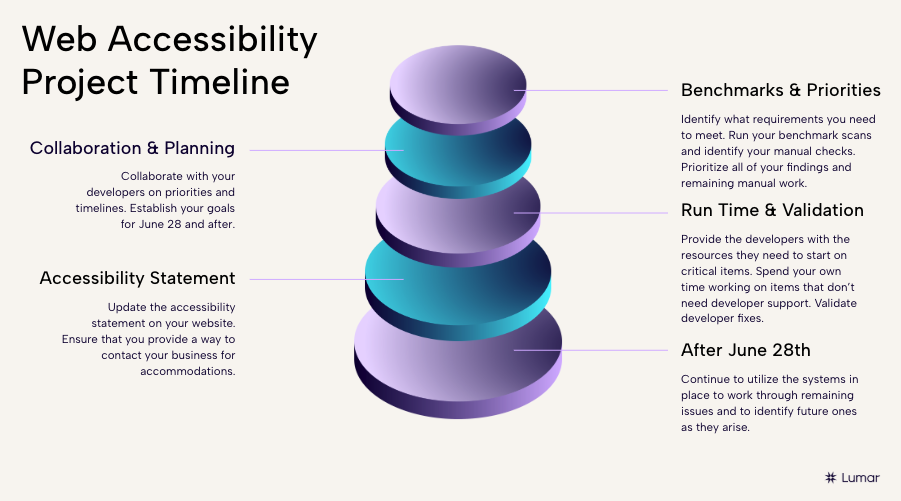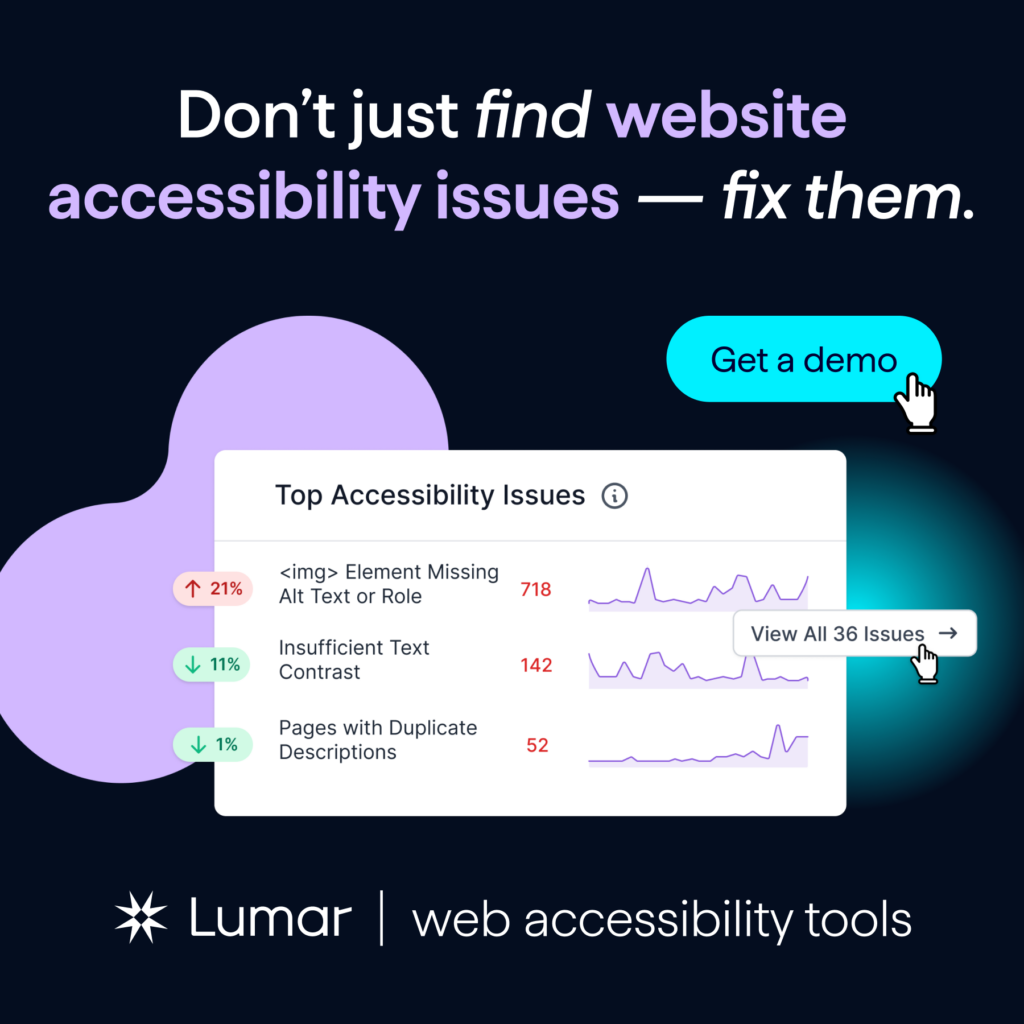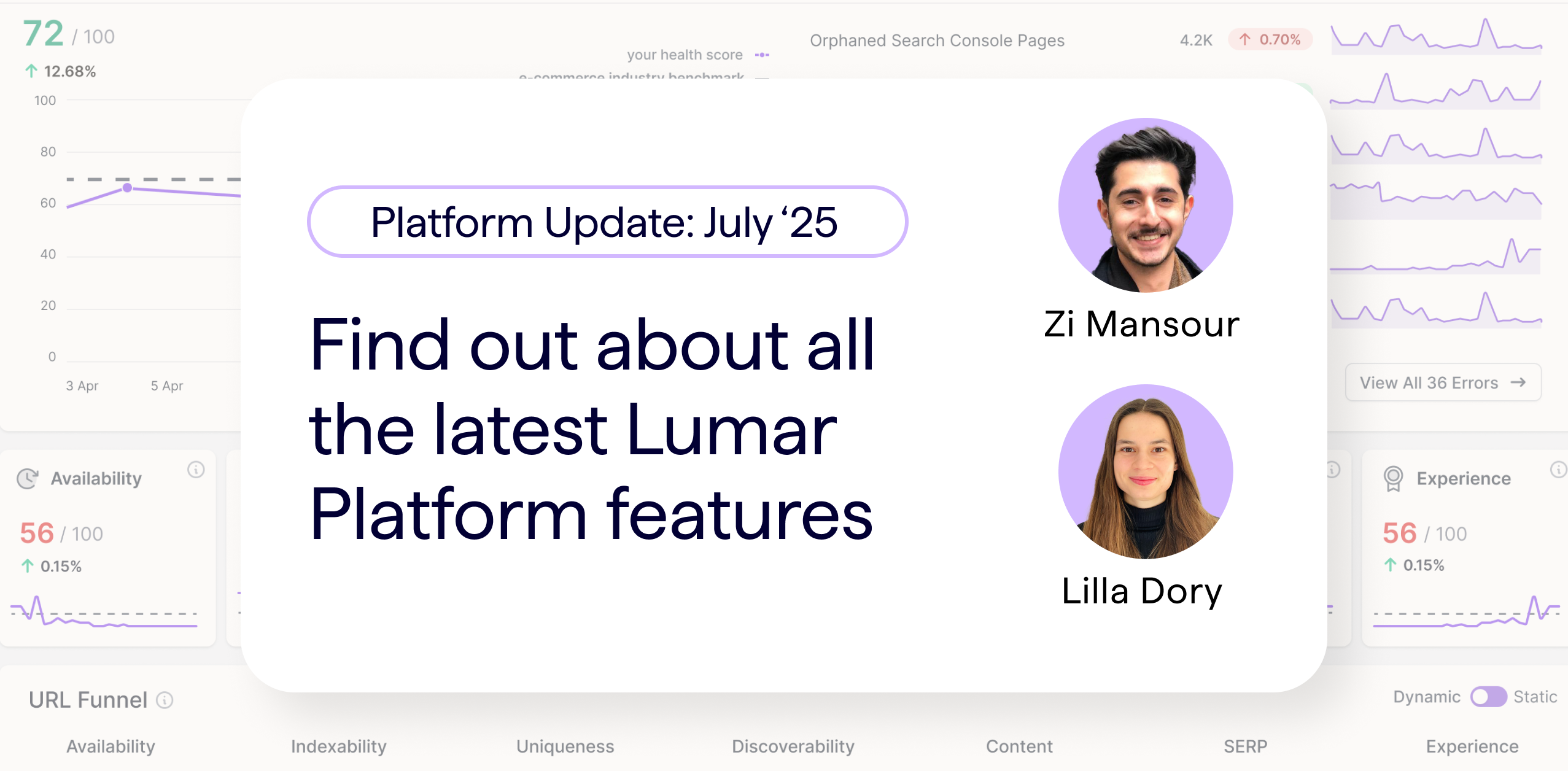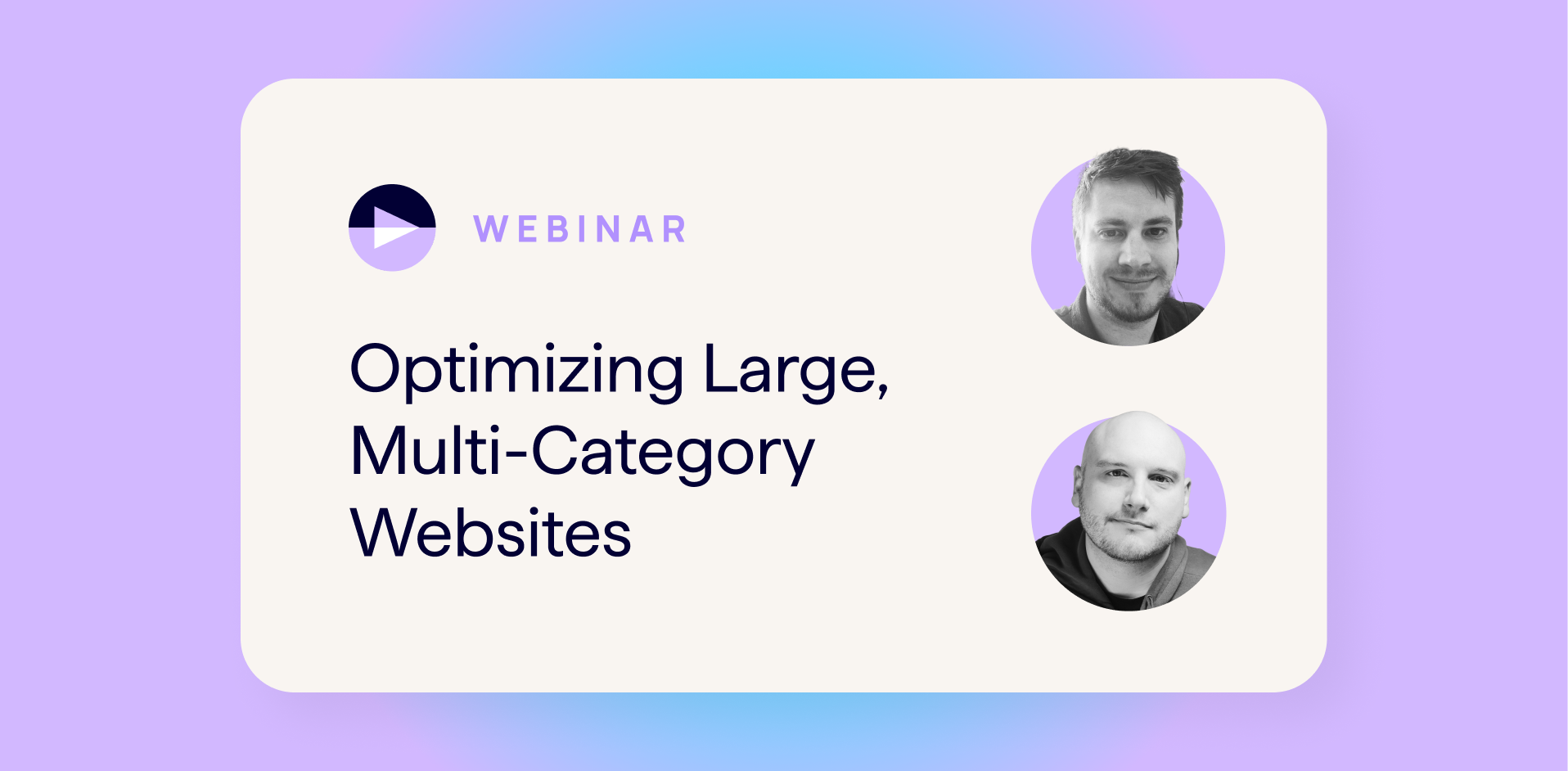Get your website ready for June’s new EU Accessibility Act rules
The June 28, 2025 European Accessibility Act (EAA) deadline is fast approaching! Is your website ready and compliant with the new rules?
Learn from web accessibility professionals in this free on-demand Lumar webinar to explore how to audit, update, and future-proof your site for EU web accessibility compliance — or read on for our top takeaways.
Meet the webinar speakers:
- Paul Morris, Director of Engineering and Accessibility Testing at QualityLogic
- Chloe Tremain, Senior SEO Specialist at Go Local Interactive
- Host: Rachael Powell, Senior Technical SEO at Lumar
Watch the entire a11y webinar session (including audience poll results and Q&A session with our web accessibility experts) above now, or continue reading for the highlights.
Want even more website strategy insights on-demand? Browse Lumar’s full library of website optimization webinars here.

EAA Website Accessibility Compliance Webinar Recap
With the European Accessibility Act (EAA) compliance deadline approaching on June 28, 2025, now is the time for website optimization professionals to ensure their digital platforms meet the requirements of this crucial legislation.
On Global Accessibility Awareness Day (GAAD), May 15, 2025, Lumar hosted a webinar exploring what digital teams need to know about the EAA and how to prepare for it effectively. (Note: The content of this session and its recap should not be considered legal advice; it covers the views and personal experiences shared by our webinar speakers.)
Understanding the European Accessibility Act (EAA) and its impact on websites doing business in the EU
While the European Accessibility Act was introduced back in 2019, its implementation has followed a structured, staggered timeline. First, each EU member state had until June 2022 to transpose the EAA directive into national law. Then, businesses have been granted until June 28, 2025, to ensure accessibility compliance for websites and digital services. (You can peruse more documentation relating to the EAA at the European Commission website.)
Related legislation & documentation to know:
- EN 301 549: This established a common digital accessibility framework across EU member states. EN 301 549 is a European accessibility standard that outlines requirements for ICT (Information and Communications Technology) products, initially focused on public procurement and systems maintained by public agencies (similar to Section 508 in the US) — the EAA is now expanding these accessibility requirements beyond the public agency realm.
- WCAG 2.1 AA: This is the required baseline for web accessibility compliance under the new EAA rules. WCAG (Web Content Accessibility Guidelines) are internationally recognized standards for web accessibility developed by the World Wide Web Consortium (W3C). They are designed to make digital content perceivable, operable, understandable, and robust for users with disabilities.
Transitional Provisions: Article 32
Article 32 of the EAA provides a transitional period for existing products and services. Specifically, services placed on the market before June 28, 2025, are granted a grace period until June 28, 2030, to achieve EAA compliance, provided no significant changes are made to them.
Paul Morris, Director of Engineering and Accessibility Testing at QualityLogic, provides more detail on this transitional provision in our webinar session:
“Now, there is another key date that I want to bring up. It’s really important. So, there’s a wonderful Article 32 in the legislation which says that services may continue to use existing products to deliver the services from before 2025 if they’re already in place.
“What we interpret that to mean is: if you’re launching your product after June 28th, you’re looking at needing to be compliant as you go out the door. But if you already exist and you don’t intend to make any changes to what you have, then you’re good through 2030 before it has to be compliant.”
However, Morris points out that, when it comes to existing products, “they don’t define what would then qualify for the product to have ‘evolved.’ Our thoughts are: if a product has gone through a fundamental change — like if you’ve got an ecommerce site and you completely rework that checkout system, it needs to be accessible in the new mode. Because if it’s changed from how it is right now, then it needs to be compliant. So, that’s how we’re believing that’s going to be interpreted … but they can introduce some grey areas.”
Watch this clip from the webinar session below:
EAA Implications for Website and Digital Teams
So, which companies doing business in Europe need to comply with the new EAA accessibility standards? Well, lots of them, as it turns out.
“It’s all about services being offered to people [in the EU],” says Morris.
The EAA’s scope encompasses a broad range of digital services, including e-commerce, banking and financial services, and public transportation services.
“Now one thing they didn’t do,” explains Morris, “is define ‘e-commerce’. We’re looking at that and saying, the e-commerce portion is basically anyone that’s providing services to a consumer, an end consumer. And by that, I mean the average person on the street. It impacts audio, it impacts digital, it impacts ebooks… and anyone who is selling through a website or mobile application — which is a large number of us, I’m sure.”
Non-compliance could result in legal actions, fines, and reputational damage. Each EU member state is responsible for enforcing the EAA, so penalties may vary accordingly.
“Each member nation has its own enforcement protocol. Each member nation has their own potential fines and enforcement policies,” says Morris, “And it’s entirely possible for any given company that’s doing business in Europe to actually end up with complaints filed from any member nation — and potentially multiple complaints filed at the same time. So this could get really interesting once it’s in place.”
Developing a digital accessibility program to meet EAA requirements
“When you’re thinking about developing all these program requirements, you also want to think about what (within your business) needs to meet these requirements,” says Chloe Tremain, Senior SEO Specialist at Go Local Interactive.
This might not only be your website itself. “If you are a software company, a vendor for your clients, you will need to be compliant with anything that’s being embedded into your clients’ websites, anything they’re serving, all of that is also going to come into scope. And if you are a vendor, your clients are probably going to ask you for documentation as well on all of your accessibility efforts and compliance,” she notes.
“So it’s not going to apply to only the website owners, it’s going to apply to all of the providers that go into that website’s existence for the (end-)customer’s use.”
“Touching on that third-party thing is really important,” agrees Morris, “Because a lot of people, when they’re bringing their website together, they’ll buy in products [like] chat bots or whatever it happens to be — you’re responsible for that, as is the vendor, of course, that your bring that product in from.”
“So when you’re thinking about becoming compliant and getting on board with [EAA], you have to think about all of the other assets that touch your site. Super important to do that while you’re trying to develop your strategy [for accessibility compliance],” notes Morris.
As you get started developing your team’s accessibility program, first determine exactly what’s applicable to your business.
“Make sure you’re scanning against the correct set of guidelines and make sure you identify any manual work that needs to be done,” says Tremain.
Tools like Lumar’s website accessibility crawler and reports can help fast-track and automate your initial web accessibility audit. But you should also identify everything you may need to manually check as well, notes Tremain.
“Run your benchmark scans, then you’ll want to go through prioritization and collaboration. Start with identifying those priorities. And I know that it can sound really overwhelming to do when you’re confronted with a giant list of hundreds of items impacting all of the pages on your website…”
“What we do, and what we find helpful, is to start with some key questions. Think about how impactful an item [on your list of uncovered accessibility issues] is.”
Tremain gives several examples of the questions to ask once you’ve conducted your website accessibility audit, have a list of all the issues on your site, and are ready to prioritize your fixes:
- Is this item a safety issue, like screen flickers that can be a safety issue for photosensitive users?
- Is this something that impacts just one page — maybe a 10-year-old blog post that gets only 3 sessions a month?
- Or is this something that’s on the homepage, where you’re getting 30,000 sessions a month?
- Are you seeing particular code snippets or embedded software issues that are impacting a large number of pages instead of just one page?
These types of ‘impact’ questions can help you prioritize your list of web accessibility fixes.
Web accessibility project framework for EAA compliance
Here is a general framework you can use to build your website accessibility project outline and its associated steps and timelines:

- Benchmarks and Priorities – Identify what requirements you need to meet. Run your benchmark accessibility scans and identify your manual checks. Prioritize all of your findings and remaining manual work.
- Collaboration and Planning – Collaborate with your developers on priorities and timelines. Establish your goals for the June 28 EAA deadline, and after.
- Run Time and Validation – Provide the developers with the resources they need to start on critical items. Spend your own time working on items that don’t need developer support. Validate developer fixes.
- Accessibility Statement – Update the accessibility statement on your website. Ensure that you provide a way to contact your business for accommodations.
- After June 28 (European Accessibility Act deadline) – Continue to utilize the systems in place to work through remaining issues and to identify future ones as they arise.
Conclusion
The European Accessibility Act represents a pivotal step toward inclusive digital experiences. For website professionals, this is an opportunity to take a leading role in creating accessible, user-friendly platforms that serve all users effectively. Proactive compliance not only mitigates legal risks but also enhances brand reputation and user satisfaction.
Don’t miss the next Lumar webinar!
Sign up for our newsletter below to be alerted about upcoming webinars, or give us a follow on LinkedIn or Twitter/X to stay up-to-date with all the latest news in website optimization.







